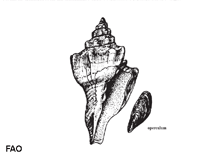Turbinella angulata (Lightfoot, 1786)
West Indian chank| Native range | All suitable habitat | Point map | Year 2050 |

|
| This map was computer-generated and has not yet been reviewed. |
| Turbinella angulata AquaMaps Data sources: GBIF OBIS |
Classification / Names Common names | Synonyms | CoL | ITIS | WoRMS
Gastropoda | Neogastropoda | Turbinellidae
Environment: milieu / climate zone / depth range / distribution range Ecology
Reef-associated; depth range 0 - 81 m (Ref. 83934). Tropical; 26°N - 9°S, 92°W - 73°E
Distribution Countries | FAO areas | Ecosystems | Occurrences | Introductions
Western Atlantic.
Length at first maturity / Size / Weight / Age
Maturity: Lm ? range ? - ? cm Max length : 36.0 cm NG male/unsexed; (Ref. 83435); common length : 35.0 cm TL male/unsexed; (Ref. 355)
Short description Morphology
Shell very large, heavy, fusiform. Sculpture of 8 to 10 prominent ribs angled at shoulder, 8 to 10 on last whorl. Columella with 3 strong folds. Colour: white, internally tinged with pink or orange.
This is one of the largest gastropods in the Atlantic Ocean (Ref. 355). Maximum depth from Ref. 109264. This species is found subtidal and offshore, in coral reefs, cienaga facies and mangroves, particularly on mud, rock, sand, and seagrass habitats (Ref. 83934).
Life cycle and mating behavior Maturity | Reproduction | Spawning | Eggs | Fecundity | Larvae
This species is a non-broadcast spawner. Life cycle does not include trocophore stage. Also Ref. 833.
Main reference
References | Coordinator | Collaborators
Leal, J.H. 2003. (Ref. 355)
IUCN Red List Status (Ref. 130435)
CITES status (Ref. 108899)
Not Evaluated
CMS (Ref. 116361)
Not Evaluated
Threat to humans
Harmless
Human uses
Fisheries: commercial
| FishSource |
Tools
More information
Internet sources
BHL | BOLD Systems | CISTI | DiscoverLife | FAO(Publication : search) | Fishipedia | GenBank (genome, nucleotide) | GloBI | Gomexsi | Google Books | Google Scholar | Google | PubMed | Tree of Life | Wikipedia (Go, Search) | Zoological Record
Estimates based on models
Preferred temperature
(Ref. 115969): 25.9 - 28.1, mean 27.5 (based on 160 cells).
Price category
(Ref. 80766):
Unknown.



